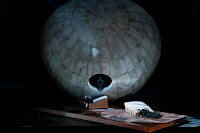When I first saw
the programme for the present opera season in the Liceu my heart sank: Tristan and Isolde was a feature. The opera famous for length and nothing much
happening on stage was set to be my early Christmas 'present' in musical terms. And yes, I am being ironic.
I had approached
the evening with increasing dread, trying to explain to Toni just what hard
work some operas could be. His response
was, “Why go?” To which my
(unsatisfactory) response was, “Have you seen the cost of the tickets!”
So, I took my
place yesterday, having remembered to turn up an hour earlier for the 7 pm
(rather than the 8 pm start for normal length operas) with something of a heavy
heart. I sank into my aisle stall seat
and waited for oblivion or ecstasy to take me!
In the event
neither did.
The opening prelude
played by the orchestra of the Liceu was beautiful with measured and detailed
playing which gave an accurate indication of the performance throughout this
long opera. In many ways the orchestra,
Orquestra Simfònic i de Gran Theatre del Liceu was the true star of the evening
as the reading of the music by the director Josep Pons was such that I was able
to appreciate details that, in spite of previous hearings, I had never truly
appreciated before.
The first
appearance of Isolde (Iréne Theorin) demonstrated the assurance that she
brought to the role throughout the evening.
Each nuance in the changing relationship of the two main characters was
easily captured by her voice which retained richness of tone and assurance no
matter whether she was singing piano
or fortissimo. The same could not be said for her Tristan
(Stefan Vinke) where, the first time that we see them both together on the deck
of the ship taking them to Cornwall, he appeared uneasy in his movement on
stage and the quality of his voice felt a little rough to me. Vinke did, however come into his own in the
second act where the mixture of power and delicacy seemed to fit the register
of his voice more happily, and he, after all, managed to sing through a role
that would have ripped lighter voices to pieces with its demands. His voice was something that I warmed to
throughout the evening and, while I never felt that he matched his Isolde in
terms of sheer quality, he was a noble partner.
Our first glimpse
of the set was of something quite minimal with a strip of film of waves at the
back of the stage suggesting the sea.
However, during the first act a giant ovoid shape was gradually lowered. At first it reminded me of a giant spider’s
egg sac, something holding a disturbing element of life within itself, but
later a photographic realization of the surface of the moon was projected onto
the shape and perhaps the idea of lifelessness and the link with the
supernatural was suggested - though the realism of the moon surface markings
suggested another interpretation.
In the second act
the giant ovoid had been turned around and looked like the shell of a massive
Easter egg. Inside the curve of this egg
were doorways, one of which, sited at the top of the egg had a curving
staircase down to the stage level. It
looked interesting and was made more so by the use of projections on the convex
surface. For the long love duet the
outlines of two trees were shown each growing branches into the other
eventually filling the space.
Projections of fire were used effectively and a clichéd but exciting
destruction sequence as the projections seemed to show the destruction of the
edifice.
Although the set
was simple, it had an epic grandeur and although it only vaguely suggested
Marke’s castle it had a majestic elegance and gave a fitting setting for the
performance of Albert Dohmen playing Marke, King of Cornwall. His voice was rich and full and he played the
role with a tired dignity that added pathos to the story without making it
mawkish.
Sarah Connolly
was an amazing Brangäne who sang superbly through her time on stage and moved
with a professional assurance which gave a dramatic unity to the narrative, as
did the other sung characters - this was an ensemble piece.
The final act had
the ovoid turned so that its concave side was facing the audience. A small ramp let up to a circular hole cut in
the side that acted as a lookout for the anticipated ship bringing Isolde to
her wounded lover. Although massively there the set never intruded, it gave a
setting, allowed action became almost a character in the action, but one that
allowed the glory to go to the singers.
A beautifully judged use of something that could have been mere
intrusion.
The final moments
of the opera had dry ice smoke pouring through the hole in the set and settling
on the bodies of the lovers, while shafts of light blazed through to the
glorious sound of the music. You might
say that it was a little over the top, but how else to you adequately end an
evening that was performed so well of an opera so awesome as this?
So, I liked it.
Much to my
amazement. I still think that there is
an orchestral symphonic poem or even symphony that I might like to hear based
on judicious selection of the music in this opera. And, yes, I know that I am showing my
essential uncouthness by suggesting that some of the music might be surplus to
requirements and that it might benefit by some cutting. But perhaps this is just another stage in my
appreciation of the music and it might suggest that there is still some way to
go before I am a true Wagnerite!


No comments:
Post a Comment